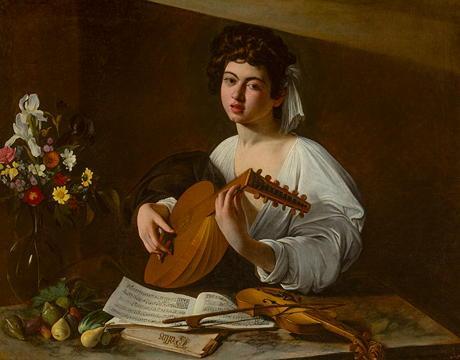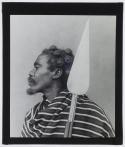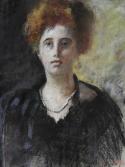Art Of The Day Weekly
#526 - from 20 September 2018 to 26 September 2018

Caravaggio, The Lute-Player, 1595-1596, huile sur toile, 94x119 cm. Coll. Hermitage State Museum, St Petersburg.
IN THE AIR
Caravaggio, the accursed genius
PARIS – There is no doubt Caravaggio would have been quickly set aside by a #MeToo campaign of the 17th century. His life was surely no example of virtue: he was guilty of sexual harassment more than once, undoubtedly robbed, obviously slapped and socked more that one person, and even killed a rival – that is one certainty since he was sentenced to death. But bad boys seem to fascinate the public: Caravaggio has become one of the most “bankable” painters. There is one mitigating circumstance in his favor: he was a genius. The exhibition at the musée Jacquemart-André presents very few of his works – ten to be precise. But this is quite an exploit for a museum out of Italy, and regarding a painter so rarely shown and jealously kept. These works are those of his Roman period, his adulthood, from 1592 to 1606, between the age of 21 and 35. They include The Lute-Player from the Hermitage or Judith beheading Holofernes. Both admired and strongly contested, Caravaggio is surrounded in the exhibition by friends, such as Gentileschi, and by rivals such as Annibale Carracci or Baglione, in order to give a balanced image of those forging years. Rome was then the true capital of the Western world, led by its strong-minded Popes. A fight takes a bad turn, a body falls on the ground, and Caravaggio has to flee at breakneck speed. He spent the last part of his life running away before dying o a beach in Tuscany. But a very recent study carried out by the Institut hospitalo-universitaire de Marseille (Hospital and University Institute of Marseille), revealed day before yesterday that, based on the analysis of the painter’s teeth, the rebel probably died foolishly from a Staphylococcus aureus. So much for the myth: the emaciated, shaky figure of a malaria-riddled artist on a Tuscan beach was so much more romantic.
• Caravage à Rome. Amis et ennemis at the musée Jacquemart-André, from 21 September 2018 to 28 January 2019.
EXHIBITIONS
Margherita Sarfatti, the Duce’s Jewish muse
MILANO – TRENTO – How can a beautiful, brilliant, cultivated, Jewish woman model a politician named Mussolini? This situation was not only a paradox, but it also lasted: Margherita Sarfatti met the young Socialist tribune in 1912, when she had just turned thirty, and followed him as his mistress for twenty years, even more so as his Pygmalion, until he befriended Hitler, and she left Italy and fled to Argentina and Uruguay. During the twenties and thirties Sarfatti was the unofficial Minister of Culture, leading this return to order, this neo-classic breath of fresh air, under the banner of the Novecento movement. She brought in the main painters of the time, and drew up an art theory of the exhibitions in Italy and abroad. Boccioni, De Chirico, Sironi, Wildt or even Funi all owe her part of their fame. Two museums have gotten together to gain recognition of the importance of this surprising deux ex machina: the museum of the Novecento in Milano and the Mart in Trento and Rovereto, which holds major archives and studies of the politics of international diffusion.
• Margherita Sarfatti. Segni, colori e luci a Milano at the Museo del Novecento, frm 21 September 2018 to 24 February 2019.
• Margherita Sarfatti. Il Novecento italiano nel mondo at the MART of Trento and Rovereto, from 22 September 2018 to 24 February 2019.

Eugène Joseph Bastard, Untitled, ca 1898-1910 © musée du quai Branly - Jacques Chirac, Photo Claude Germain.
Madagascar, a tour of an island
PARIS - The large Island, or ylang-ylang, represents vanilla and paradise-like beaches. Where great poverty also reign, with a minimum wage hardly over a dollar a day. When we draw up the portrait of Madagascar, in which we can also include recurrent political upheavals, we forget that this island-continent, larger than France, has a true artistic culture. The exhibition at the museum on quai Branly, though contested for some of its shortcomings, nevertheless fills in a void: ever since the retrospective at the Musée de l’Homme in 1946, no global panorama of Malagasy arts had been presented in France. One had better bring along a glossary to recognize objects that are exotic by nature, such as the felana, a shell hung from one’s forehead, a thousand light years from imported art, which then found its place: the island was discovered in 1500 by the Europeans, and the technique of painting spread around 1850 so the local dignitaries could be represented in Western attire, with an umbrella and a straw hat. But bodily ornaments, amulets, funerary posts continued to survive, a proof of the importance of the rites of passage we eliminated.
• Madagascar, arts de la Grande Ile at the musée du quai Branly, from 17 September 2018 to 1 January 2019.
BOOKS
My portrait by Rembrandt
It is quite amazing to be Dutch, to be an art historian, and to unearth an authentic portrait by Rembrandt in an auction when the said painting was mistakenly written into the catalogue as being from “the school of Rembrandt”. But when your name is Jan Six, that you come from a famous family in Amsterdam, and that you discover that the model for the painting by Rembrandt has exactly your name, and that he is your ancestor: now that is more than a fairy tale! That is what the hero of this story tells us of his amazing discovery in 2016, confirmed in 2018 by Ernst van de Wetering, the number one specialist of the great painter and director of the Rembrandt Research Project for the last forty years. The investigation is described in detail, from the format and the origin of the canvas, the pigments used, the provenance, the analysis of the scenery to the clothing – goat gloves, French lace collar, batiste cuffs with frills – and holds some surprising discoveries. This vertical man’s portrait was part of a larger, horizontal composition that included a woman! Rembrandt has accustomed us to the fact that his paintings were often cut and cropped. Even his famous Night Watch which misses a piece. All these steps were necessary to reach the conclusion many will continue to contest but no one will be able to equal: it is a Rembrandt, and it bears his signature.
• Le portrait d’un jeune homme de Rembrandt, by Jan Six, Payot, 160 p., €20.



